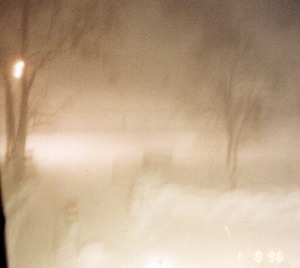Last in our Christmas Concert's opening remarks, I mentioned Frank Capra's Christmas classic, It's a Wonderful Life. I had a large woven laundry basket in my hands and described the last scene of that movie when all the neighbors come into the living room of the Bailey home with a laundry basket full of collected money for a friend in need.
After explaining our "Under One Roof" project (bringing all classrooms into the main building over Christmas Break) and the stated goal of $3,000 to cover related costs, I said, "If we fall short of our goal, I'll not get up and take another offering, but I will set this laundry basket over here on the stage, and if you'd like to give more, we will greatly appreciate it." We prayed and the ushers passed smaller versions of the laundry basket through the rows of family and friends.
I'll not go into detail here, but we did not need to put the laundry basket back on the stage at the end of the program. After counting the offering, it was full and running over with cash offerings triple their normal amount from years past and a total far more than DOUBLE the ambitious stated goal.
Imagine with me that the picture below of over 600 "neighbors" is not in Bedford Falls, NY but in Fruitport, MI, gathered not at George Bailey's home but in the living room of our school with standing room only in the back. It was by far the best-attended Christmas program in the history of our school, and the fellowship before and after was very much like the closing scene of that 1946 film. It was a wonderful night in the wonderful life we all share at CCS.
Our annual Christmas concert is full of traditions. For instance, the band plays "Sleigh Ride" each year and invites alumni and alumni parents to come up with their instruments and join in that iconic song. This year there seemed to be more "joiners" than ever, packing the stage.
Then at the end of the program, a new tradition began: the high school choir had about 20 alumni, parents and teachers join them in singing the Hallelujah Chorus. I was one of the adults singing with them, and at the end as we closed with a congregational song, I could not resist taking the first picture above of this festive gathering. Mrs. Andrea Masvero took the reverse-angle below.
As we all sang last night, "We give Him all the glory!" and we thank all those who gave in this special offering which will pay for facility repairs/upgrades, 4 additional security cameras (to add to our 16 already in place), and improvements associated with our "Under One Roof" Project to be completed in the weeks ahead. Please continue to pray that the broader financial goals stated in the 2012 Annual Fund Letter will also be met through unprecedented philanthropic support.
CCS is a 501(c)(3) non-profit educational organization. All gifts are fully tax deductible..
On behalf of our students and staff, let me say thank you to all who are a part of this ongoing effort, generous giving, and uplifting prayer for Calvary Christian Schools.
Have a very Merry Christmas!
Tom Kapanka
Then at the end of the program, a new tradition began: the high school choir had about 20 alumni, parents and teachers join them in singing the Hallelujah Chorus. I was one of the adults singing with them, and at the end as we closed with a congregational song, I could not resist taking the first picture above of this festive gathering. Mrs. Andrea Masvero took the reverse-angle below.
As we all sang last night, "We give Him all the glory!" and we thank all those who gave in this special offering which will pay for facility repairs/upgrades, 4 additional security cameras (to add to our 16 already in place), and improvements associated with our "Under One Roof" Project to be completed in the weeks ahead. Please continue to pray that the broader financial goals stated in the 2012 Annual Fund Letter will also be met through unprecedented philanthropic support.
CCS is a 501(c)(3) non-profit educational organization. All gifts are fully tax deductible..
On behalf of our students and staff, let me say thank you to all who are a part of this ongoing effort, generous giving, and uplifting prayer for Calvary Christian Schools.
Have a very Merry Christmas!
Tom Kapanka
If you've never seen the full movie "It's a Wonderful Life" below is the public domain version:












